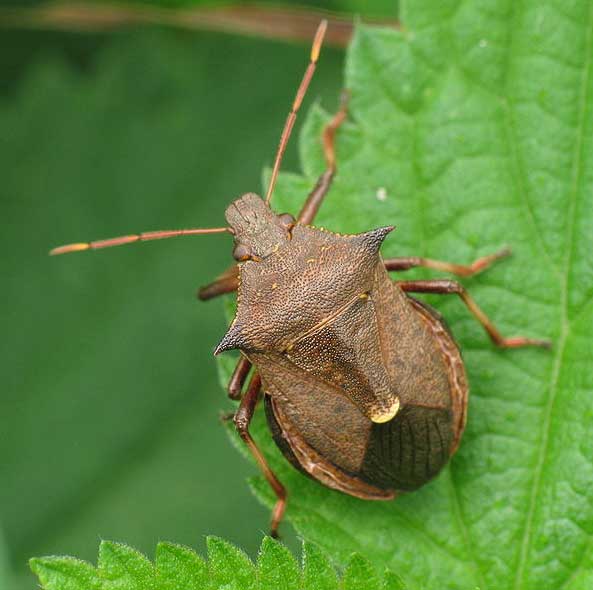
Picromerus bidens (*)
Superregnum: Eukaryota
Regnum: Animalia
Subregnum: Eumetazoa
Cladus: Bilateria
Cladus: Nephrozoa
Cladus: Protostomia
Cladus: Ecdysozoa
Cladus: Panarthropoda
Phylum: Arthropoda
Subphylum: Hexapoda
Classis: Insecta
Cladus: Dicondylia
Subclassis: Pterygota
Cladus: Metapterygota
Infraclassis: Neoptera
Cladus: Eumetabola
Cladus: Paraneoptera
Superordo: Condylognatha
Ordo: Hemiptera
Subordo: Heteroptera
Infraordo: Pentatomomorpha
Superfamilia: Pentatomoidea
Familia: Pentatomidae
Subfamilia: Asopinae
Genus: Picromerus
Species: Picromerus bidens
Name
Picromerus bidens (Linnaeus, 1758:443)
Synonyms
Cimex bidens Linnaeus, 1758:443
Cimex bilobus Schrank, 1781:268 [Synonymized by Schrank, 1782:277]
Pentatoma bidens Latreille, 1804:188
Arma bidens Hahn, 1832:92
Asopus bidens Burmeister, 1835:379
Jalla bidens Spinola, 1837:335
Stiretrus bidens Blanchard, 1840:153
Picromerus bidens Amyot & Serville, 1843:84
Picromerus fuscoannulatus Stål, 1858:176 [Synonymized by Kerzhner, 1964:367]
Asopus (Picromerus) bidens Flor, 1860:92
Cimex fusco-annulatus Stål, 1870:46
Picromerus longicollis Jakovlev, 1902:335 [Synonymized with fuscoannulatus by Kerzhner, 1964:367]
Picromerus bidens fuscoannulatus Kerzhner, 1964:87
References
Primary references
Linnaeus, C. 1758. Systema Naturae per regna tria naturae, secundum classes, ordines, genera, species, cum characteribus, differentiis, synonymis, locis. Editio Decima, Reformata. Tomus I. Holmiæ (Stockholm): impensis direct. Laurentii Salvii. 824 pp. DOI: 10.5962/bhl.title.542 [first availability: page 443] BHL Reference page.
Additional references
Ahmad, I. & Önder, F. 1990. A revision of the genus Picromerus Amyot and Serville (Hemiptera: Pentatomidae: Pentatomillae: Asopini) from western Palaearctic with description of two new species from Turkey. Türkiye Entomologii Dergisi 14(2): 75–84. Online Reference page.
Rider, D.A. 2006. Family Pentatomidae. p. 233–403, In: Aukema, A. & Rieger, C. (eds). Catalogue of the Heteroptera of the Palaearctic Region, vol 5. The Netherlands Entomological Society, Amsterdam. ResearchGate Open access PDF. Reference page. [p. 243]
Thomas, D.B. 1994. Taxonomic synopsis of the Old World asopine genera (Heteroptera: Pentatomidae). Insecta Mundi 8(3–4): 145–212. Online. Reference page. [p. 191]
Links
Zicha, Ondřej et al. Picromerus bidens (Linnaeus, 1758) – Taxon details on Biological Library (BioLib).
Picromerus bidens – Taxon details on Encyclopedia of Life (EOL).
Picromerus bidens (Linnaeus, 1758) – Taxon details on Fauna Europaea.
Global Biodiversity Information Facility. 2019. GBIF Backbone Taxonomy. Checklist dataset. Taxon: Picromerus bidens.
ION
ZooBank: BB3FFB97-A7C5-44F5-89D3-E28611920FD1
Picromerus bidens, the spiny shieldbug or spiked shieldbug, is a carnivorous species of shield bug in the family Pentatomidae.[2]
Distribution and habitat
This species has a wide distribution in the Palaearctic, from 64°N to North Africa and from the British Isles to China. It has also been introduced, probably more than once, to North America, where it has been recorded from more than 180 sites.[3]
Habitat
These bugs prefer deciduous and mixed forests, heathland, gardens, chalk downland and damp flower-rich meadows.[4]
Description
Final instar nymph
Picromerus bidens feeding on a European peacock caterpillar
Picromerus bidens is a large (12 to 13.5 mm long) and distinctive predatory shieldbug. It shows a thick rostrum directed away from head. Body colour is quite variable, generally light to dark brown or bluish, with red-brown antennae and legs and two unmistakable thorn-like brown projections on the sides of the pronotum (hence the species name bidens, meaning "with two teeth"). Front femurs are armed with a ventral spine distally.[4][5] The early instar nymphs are commonly reddish, while the final instar nymphs are greyish black, with banded antennae and legs.[4]
Biology
Both adults and nymphs of the spiny shieldbugs are predatory, feeding on the larvae of other insects, especially on leaf bugs, beetles, aphids and caterpillars. The choice of the prey depend on the season and availability of food. However both adults and nymphs also suck sap from plants. The female lays eggs on tree trunks and leaves. In the spring the larvae hatch, growing to the adult bugs after five moultings. Nymphs become adults by July or August and adults can be found until November. This species usually overwinters as eggs and less frequently as nymphs.[4][6][7][8]
Bibliography
Dmitry L. Musolin, Aida H. Saulich: Summer dormancy ensures univoltinism in the predatory bug Picromerus bidens. Entomologia Experimentalis et Applicata, 95, 3, S. 259–267, 2000 doi:10.1046/j.1570-7458.2000.00665.x
Kamran Mahdian, Luc Tirry & Patrick De Clercq: Development of the predatory pentatomid Picromerus bidens (L.) at various constant temperatures. Belg. J. Zool., 138, 2, S. 135–139, 2008
Kamran Mahdian, Luc Tirry & Patrick De Clercq: Functional response of Picromerus bidens: effects of host plant. Journal of Applied Entomology, 131, 3, S. 160–164, 2007 doi:10.1111/j.1439-0418.2006.01124.x
Kamran Mahdian, Thomas Van Leeuwen, Luc Tirry and Patrick De Clercq: Susceptibility of the predatory stinkbug Picromerus bidens to selected insecticides. BioControl, 52, 6, S. 765–774, 2007 doi:10.1007/s10526-007-9075-3
Martin Konvicka, Vladimir Hula und Zdenek Fric: Picromerus bidens (Heteroptera: Pentatomidae) as predator of the Checkerspot Euphydryas aurinia (Lepidoptera: Nymphalidae). Entomologica Fennica, 16, S. 233–236, 2005 PDF
T. R. E. Southwood und D. Leston: Land and Water Bugs of the British Isles. Frederick Warne & Co. Ltd., 1959
References
"Picromerus bidens (Linnaeus, 1758)". Encyclopedia of Life. Retrieved 2009-02-05.
Biolib
Fauna europaea
British Bugs
S.M. Paiero, S.A. Marshall, J.E. McPherson, and M.-S. Ma Stink bugs (Pentatomidae) and parent bugs (Acanthosomatidae) of Ontario and adjacent areas: A key to species and a review of the fauna
Dmitry L. Musolin & Aida H. Saulich (2000). "Summer dormancy ensures univoltinism in the predatory bug Picromerus bidens". Entomologia Experimentalis et Applicata. 95 (3): 259–267. doi:10.1046/j.1570-7458.2000.00665.x. Archived from the original on 2013-01-05.
Mahdian, Kamran; Tirry, Luc; De Clercq, Patrick (2008). "Development of the predatory pentatomid Picromerus bidens (L.) at various constant temperatures". Belgian Journal of Zoology. 138 (2): 135–139.
Insektenbox
Retrieved from "http://en.wikipedia.org/"
All text is available under the terms of the GNU Free Documentation License

